Karlsruhe Palace
Last updated
Karlsruhe Palace (German : Karlsruher Schloss) was built in 1715 for Margrave Charles III William of Baden-Durlach after a dispute with the citizens of his previous capital, Durlach. The city of Karlsruhe has since grown around it. The building is now home to the main museum of the Badisches Landesmuseum. [1]
Contents
History
The first building was constructed by Jakob Friedrich von Batzendorf. The city was planned with the tower of the palace (Schloss) at the centre and 32 streets radiating out from it like spokes on a wheel, or ribs on a folding fan, so that a nickname for Karlsruhe in German is the "fan city" (Fächerstadt).
Originally partially made of wood, the palace had to be rebuilt in 1746, using stone. Charles Frederick, Margrave of Baden-Durlach at the time and who eventually became Charles Frederick, Grand Duke of Baden, then had the palace altered by Balthasar Neumann and Friedrich von Kesslau until 1770, adding larger windows and doors, pavilions and wings. In 1785, Wilhelm Jeremias Müller shortened the tower, adding a cupola.
During the Revolutions of 1848, Leopold, Grand Duke of Baden, was expelled in 1849 for some time. In 1918, the last monarch, Frederick II, Grand Duke of Baden, had to move out. The former residence of the rulers of Baden is now used as the Badisches Landesmuseum Karlsruhe.
Much of the city centre, including the palace, was reduced to rubble by Allied bombing during World War II but was quickly rebuilt after the war.


Gallery
- Karlsruhe Palace, drone view from front
- Chinese Tea huts
- Front view (February 2005)
- The palace at night
- View from the townhall tower
- The palace at night with Menorah (Hanukkah)
- The palace during a youth convention
- The palace during the summer
- The palace with Christmas illumination
- Two wheels in front of the palace during Heimattage celebrations in 2017
See also
Related Research Articles

Durlach is a borough of the German city of Karlsruhe with a population of roughly 30,000.
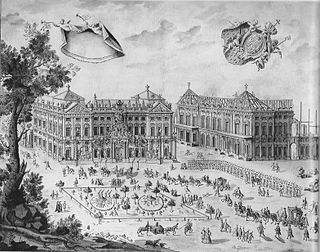
Residenz is a German word for "place of living", now obsolete except in the formal sense of an official residence. A related term, Residenzstadt, denotes a city where a sovereign ruler resided, therefore carrying a similar meaning as the modern expressions seat of government or capital. As there were many sovereign rulers in the Holy Roman Empire, ranking from Lord (Herr) to prince elector and king, there are many cities, palaces, and castles in the empire's former territory which used to be a residenz and are partially still so referred to today. The former residenz status of a city is frequently reflected by the architecture of its center. During the baroque period especially, many prestigious buildings were erected, sometimes even new towns were founded. Today, former Residenzstädte mostly still serve as cultural and administrative centers.
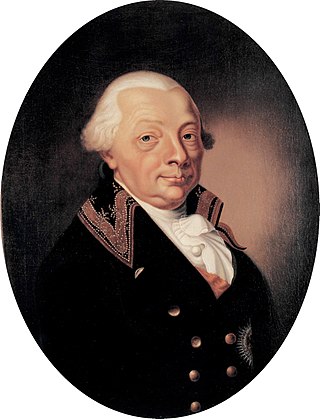
Charles Frederick was Margrave, Elector and later Grand Duke of Baden from 1738 until his death.

The Margraviate of Baden was a historical territory of the Holy Roman Empire. Spread along the east side of the Upper Rhine river in southwestern Germany, it was named a margraviate in 1112 and existed until 1535, when it was split into the two margraviates of Baden-Durlach and Baden-Baden. The two parts were reunited in 1771 under Margrave Charles Frederick, even if the three parts of the state maintained their distinct seats to the Reichstag. The restored Margraviate of Baden was elevated to the status of electorate in 1803. In 1806, the Electorate of Baden, receiving territorial additions, became the Grand Duchy of Baden. The rulers of Baden, known as the House of Baden, were a cadet line of the Swabian House of Zähringen.
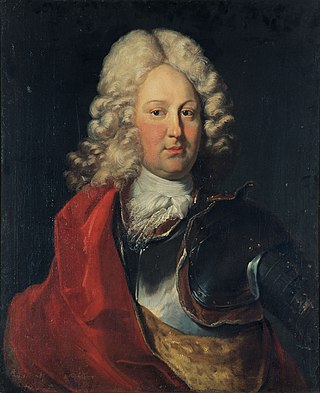
Charles III William was Margrave of Baden-Durlach between 1709 and 1738. He was the son of Margrave Frederick Magnus of Baden-Durlach and Augusta Maria of Schleswig-Holstein-Gottorp. In 1715, he established Karlsruhe, where he built his residence. Karlsruhe has since grown to a large city. With the consolidation of public finances and the creation of a reliable administration, he laid the foundations for the reform policies of his grandson, Charles Frederick.

The Margraviate of Baden-Durlach was an early modern territory of the Holy Roman Empire, in the upper Rhine valley, which existed from 1535 to 1771. It was formed when the Margraviate of Baden was split between the sons of Margrave Christopher I and was named for its capital, Durlach. The other half of the territory became the Margraviate of Baden-Baden, located between the two halves of Baden-Durlach. Baden-Durlach became Lutheran during the Protestant Reformation, unlike Baden-Baden, which remained Catholic. Baden-Durlach occupied Baden-Baden from 1594 to 1622, but was driven out after being defeated at the Battle of Wimpfen, during the Thirty Years' War (1618-1648). The territory was ravaged during the Nine Years' War (1688-1697). Following the extinction of the Baden-Baden line in 1771, the Baden-Durlach inherited their territories and reunited the Margraviate of Baden. The reunified territory was caught up in the French Revolutionary and Napoleonic Wars, emerging in 1806 as the Grand Duchy of Baden.

Augustus George, Margrave of Baden-Baden was the ruling Margrave of Baden-Baden from 1761 till his death in 1771. He succeeded his brother Louis George and was the brother of the Duchess of Orléans. He was the son-in-law of Duke Léopold Philippe d'Arenberg.

Princess Caroline Louise of Hesse-Darmstadt, was a consort of Baden, a dilettante artist, scientist, collector and salonist.

William Louis of Baden-Durlach was the brother of the first Grand Duke of Baden, Charles Frederick. In 1753 he became governor of the province of Gelderland based in Arnhem. In 1766 he was appointed by the Netherlands States-General to lieutenant general. After 1769 William Louis was also active as an industrialist.

Magdalena Wilhelmine of Württemberg was a margravine of Baden. She had a place in the regency during the minority of her grandson in 1738-42.

Christopher of Baden-Durlach was Prince and (titular) Margrave of Baden-Durlach.
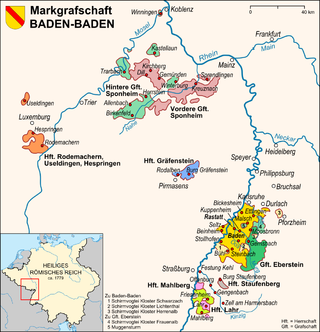
The Margraviate of Baden-Baden was an early modern southwest German territory within the Holy Roman Empire. It was created in 1535 along with the Margraviate of Baden-Durlach as a result of the division of the Margraviate of Baden. Its territory consisted of a core area on the middle stretch of the Upper Rhine around the capital city of Baden, as well as lordships on the Moselle and Nahe.

Karlsburg Castle in the Durlach district of Karlsruhe characterizes the history of the Baden since 1563. Only the Prinzessinnenbau of the historical building still stands.
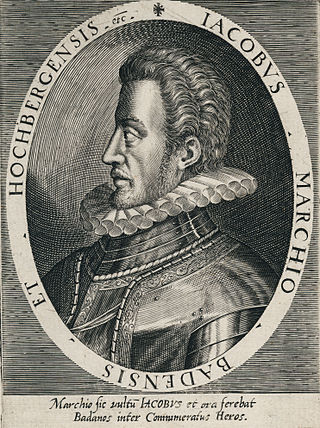
Margrave James III of Baden-Hachberg was margrave of Baden-Hachberg from 1584 to 1590 and resided at Emmendingen. He converted, in 1590, from Lutheranism to the Roman Catholic confession, causing some political turmoil.

Crown of Baden, also known as the Grand Ducal Crown of Baden is a crown formerly used by the Grand Duke of Baden and part of the Crown Jewels of Baden. The crown is 26 cm high and has a diameter of 13,8 cm. Today the crown is kept at the Baden State Museum, which itself was built within the old walls of the former Karlsruhe Palace.
Karl Joseph Obser was a German archivist and historian, largely known for his studies on the history of Baden during the 18th and early 19th century.
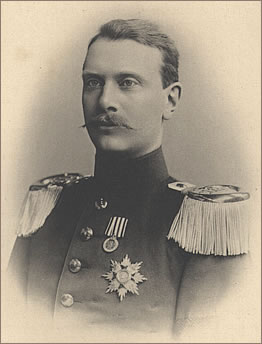
The House Order of Fidelity is a dynastic order of the Margraviate of Baden. It was established by Charles III William, Margrave of Baden-Durlach as a reward for merit and to mark the laying of the foundation stone of his residence at Karlsruhe Palace. As was customary at that time, it was originally named in French as the Ordre de la Fidélité, before later being renamed the Orden der Treue and finally in 1840 the Hausorden der Treue. Its motto was Fidelitas, which is also part of Karlsruhe, Germany's coat of arms.

Barbara of Württemberg was margravine of the historical German territory of Baden-Durlach. The daughter of Frederick I, Duke of Württemberg and his wife, Sibylla of Anhalt, she was born a Duchess of Württemberg and became margravine after marrying Frederick V, Margrave of Baden-Durlach, in 1616. She is depicted as Saint Barbara in a posthumous miniature portrait.

The New Castle on the Florentinerberg in Baden-Baden was the seat of the Margraves of Baden from the late 15th century to the end of the 17th century and of the Margraves of Baden-Baden from 1535. As a castle complex from the Late Middle Ages, it has been rebuilt and extended several times. Today, the listed building is owned by Kuwaiti investors who wanted to convert the castle into a luxury hotel.

The Baden State Museum in Karlsruhe is the large cultural, art and regional history museum of the Baden region of Baden-Württemberg. With its globally significant collections, representing more than 50,000 years of international cultural history, it conveys history and historical living environments. Its collections range from prehistory and early history to the Middle Ages and the 21st century. The museum was founded in 1919 and opened in 1921 in the rooms of Karlsruhe Palace.
References
External links
Text is available under the CC BY-SA 4.0 license; additional terms may apply.
Images, videos and audio are available under their respective licenses.








